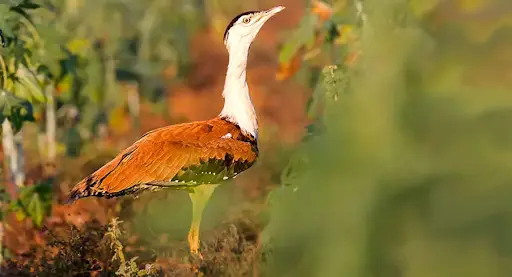Friday, 5th July 2024
RBI’s Surplus: To Spend or Not to Spend
Why in the news?
- With a new government in office, attention has turned towards the Union Budget for 2024-25.
- A significant development preceding this budget is the Reserve Bank of India's (RBI) announcement of a substantial dividend transfer to the government, exceeding initial expectations.
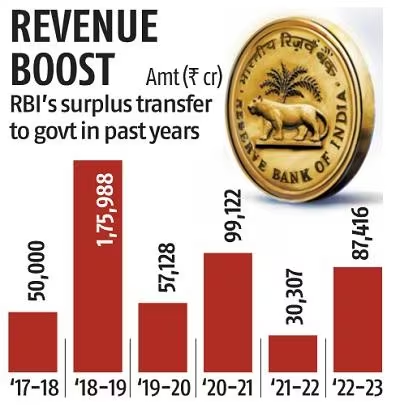
Fiscal Management Principles & Purpose:
- Fiscal Management Principles:
- Prudent Deficits: Fiscal management should ideally maintain deficits around 3% of GDP for the Centre, as stipulated by the Fiscal Responsibility and Budget Management (FRBM) Act.
- Cyclical Spending: Governments should adjust spending based on economic conditions—increasing during downturns to stimulate demand and scaling back during recoveries to prevent inflationary pressures.
- Purpose:
- The objective of varying deficits is to stabilise the economy by supporting demand during economic downturns and controlling inflation during periods of recovery.
- Symmetric policies are crucial—larger deficits during downturns should be followed by smaller deficits to stabilise government debt.
India’s Fiscal Challenges:
- Historical Context of Fiscal Deficit:
- India's average fiscal deficit from 2000-01 to 2019-20 was 4.6% of GDP, above the FRBM Act's 3% target.
- Despite legislative efforts, adherence to the 3% norm has been challenging due to economic needs and developmental pressures.
- Structural Issues and Economic Pressures:
- Challenges include a large population, developmental demands, and limited tax base efficiency.
- These factors contribute to persistent borrowing and fiscal deficits.
- Pandemic-Induced Challenges:
- The COVID-19 pandemic exacerbated fiscal pressures, leading to a high deficit of 9.2% of GDP in 2020-21.
- Government intervention was necessary to support the economy during the crisis, impacting fiscal targets.
- Post-Pandemic Fiscal Policies:
- Efforts to reduce deficits post-pandemic have been gradual, with the 2024-25 Interim Budget targeting a deficit of 5.1%.
- Balancing economic recovery with fiscal discipline remains complex.
- RBI’s Unexpected Dividend and Debate on Capital Expenditure (Capex)
- The RBI's Rs 2.11 lakh crore dividend to the government has sparked discussions on utilising this windfall.
- Some suggest increasing capital expenditure (capex), although the Interim Budget plans indicate a slowdown in capex growth for 2024-25.
- Critics argue against increased capex, cautioning against hasty spending decisions despite the surplus dividend.
The General Sentiment on Capex, Purpose of Capex Spending, and the Assessment of the Necessity of Capex:
- The General Sentiment on Capex
- There is a widespread belief in India that any expenditure on Capex is positive news, which may not always be accurate.
- China, for instance, faced challenges after undertaking extensive infrastructure projects, such as multiple airports in the same city, leading to debt repayment struggles.
- India needs a strategic approach to determine the necessary amount and type of Capex required.
- Purpose of Capex Spending
- Governments engage in Capex for two primary reasons: to stimulate economic growth and to address infrastructure needs.
- While India faces significant infrastructure challenges, the approach should prioritise sustainable development over rapid expansion.
- Post-pandemic, India has seen Capex grow annually by approximately 30%, raising questions about the sustainability and focus on new projects over maintenance.
- Assessing the Necessity of Capex
- Not all Capex contributes equally to economic growth.
- For example, investing Rs 1.6 lakh crore to revitalise state-owned telecom companies MTNL and BSNL may not be critical, especially with private operators providing affordable cell phone services nationwide.
- Similarly, large investments in projects like bullet trains, given India's relatively low per capita income (less than $2,500), may not be economically justified.
Way Forward:
- The government should assess whether economic stimulus is necessary given the current strong economic performance.
- Instead of increasing spending, the surplus dividend from the RBI could be utilised to reduce the fiscal deficit closer to the targeted three per cent of GDP.
- It's essential to accurately gauge the true state of the Indian economy; if growth figures are inflated, there may be a case for continued government spending to support economic stability.
Conclusion:
India faces a complex fiscal discipline challenge due to structural issues worsened by economic shocks like COVID-19. Efforts to control the fiscal deficit have been made, yet persistent high deficits and growing debt underscore the necessity for deeper structural reforms and a steadfast commitment to fiscal prudence. Achieving this balance is critical to ensuring sustained economic stability and fostering long-term growth.
|
UPSC Civil Services Examination, Previous Year Questions (PYQs) Prelims Q1. If the RBI decides to adopt an expansionist monetary policy, which of the following would it not do (2020)
Select the correct answer using the code given below:
Ans: (b) Q2. With reference to Indian economy, consider the following: (2015)
Which of the above is/are components/ components of Monetary Policy?
Ans: (c) |
Source: IE
Climate Resilient Agriculture
Why in the News?
- Recently, the Union government plans to unveil a framework to promote climate-resilient agriculture in 50,000 villages from 310 districts that have already been identified as climatically-vulnerable.
- These 310 districts are spread across 27 states, with Uttar Pradesh accounting for the most districts (48), followed by Rajasthan (27).
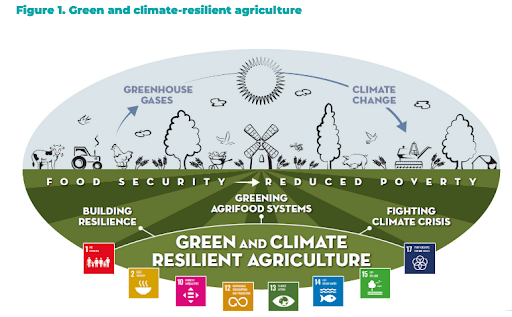
About Climate Resilient Agriculture:
- Climate Resilient Agriculture (CRA) refers to farming practices and strategies designed to withstand and adapt to the changing climate.
- In India, where agriculture is a major part of the economy and livelihood for millions, CRA is essential to ensure food security, economic stability, and sustainable development.
- There are 11 National Missions as part of the Union Government’s National Action Plan on Climate Change (NAPCC).
Key Components / Features of CRA:
- Diversified Cropping Systems:
- Mixed Cropping: Growing multiple crops on the same land to reduce the risk of crop failure due to extreme weather.
- Crop Rotation: Changing the type of crop grown in a particular field each season to improve soil health and reduce pests.
- Improved Water Management:
- Rainwater Harvesting: Collecting and storing rainwater for use during dry periods.
- Efficient Irrigation: Using methods like drip irrigation to minimise water wastage and ensure crops get the right amount of water.
- Soil Health Enhancement:
- Organic Farming: Using natural fertilisers and pesticides to maintain soil fertility and health.
- Conservation Tillage: Minimising soil disturbance to maintain soil structure and reduce erosion.
- Adoption of Stress-Tolerant Crop Varieties:
- Developing and planting crop varieties that can withstand drought, floods, and other climate extremes.
- Agroforestry:
- Integrating trees and shrubs into farming systems to protect crops, enhance biodiversity, and improve soil and water quality.
- Weather and Climate Services:
- Providing farmers with accurate weather forecasts and climate information to help them plan their activities better and reduce risks.
- Risk Management and Insurance:
- Offering crop insurance schemes to protect farmers against losses due to extreme weather events.
Benefits of CRA:
- Increased Productivity: By using resilient practices, farmers can maintain or even increase their crop yields despite adverse weather conditions.
- Enhanced Livelihoods: Stable agricultural production ensures a consistent income for farmers and reduces poverty.
- Environmental Sustainability: CRA practices promote the sustainable use of natural resources, ensuring long-term agricultural productivity.
- Food Security: With reliable agricultural output, the availability of food is more secure, benefiting the entire population.
Challenges of Climate Resilient Agriculture (CRA):
- Awareness and Adoption: Encouraging farmers to adopt new practices and technologies requires awareness-building and education, which can be challenging in rural and remote areas.
- Cost and Investment: Implementing CRA practices often requires initial investments in infrastructure such as water harvesting structures and irrigation systems, which may be prohibitive for smallholder farmers.
- Access to Resources: Small-scale farmers may face challenges in accessing quality seeds, inputs like fertilisers and pesticides, and technical knowledge required for implementing CRA practices effectively.
- Climate Variability: Rapid changes in weather patterns and unpredictable climate events pose ongoing challenges to planning and implementing resilient farming practices.
- Scaling Up: Scaling up successful CRA initiatives from pilot projects to broader implementation across regions requires overcoming logistical, institutional, and financial barriers.
ICAR’s Climate Smart Agriculture Program:
- Consortium for Scaling-Up Climate Smart Agriculture (C-SUCSeS):
- Led by the Indian Council of Agricultural Research (ICAR).
- Aims to increase agricultural production sustainably in South Asia.
- Focuses on improving food security, nutrition, and income across SAARC countries.
- Promotes collaboration on climate-smart technologies and practices among research centres and extension agencies.
- Regional Cooperation:
- South Asian governments are exploring a regional seed bank and seed testing framework.
- ICAR and SAARC organise joint training programs to enhance agricultural skills.
- Government Commitment:
- India pledges increased investment, research, technical cooperation, and adoption of innovative agricultural technologies.
- Aims to boost productivity and ensure food security in South Asia.
Climate-resilient agriculture in 50,000 villages:
- Union government to unveil a framework promoting climate-resilient agriculture.
- Targeting 50,000 villages in climatically-vulnerable districts across 27 states.
- Uttar Pradesh has the highest number of vulnerable districts (48), followed by Rajasthan (27).
- Part of the Ministry of Agriculture and Farmers’ Welfare's 100-day agenda.
- ICAR has developed over 2,000 crop varieties aimed at enhancing food production
|
UPSC Civil Services Examination, Previous Year Question (PYQ) Prelims Q:1 How is permaculture farming different from conventional chemical farming? (2021)
Select the correct answer using the code given below.
Ans: (b) Q:2 Which of the following is the chief characteristic of ‘mixed farming’? (2012)
Ans: (c) Q.3 With reference to micro-irrigation, which of the following statements is/are correct? (2011)
Select the correct answer using the codes given below:
Ans: (c) Mains Q.1 What are the present challenges before crop diversification? How do emerging technologies provide an opportunity for crop diversification? (2021) Q.2 How has India benefited from the contributions of Sir M. Visvesvaraya and Dr. M. S. Swaminathan in the fields of water engineering and agricultural science respectively? (2019) |
Source: IE
National Quantum Mission
Why in the news ?
- Itihaasa, a non-profit organisation, has recently released an assessment of India’s National Quantum Mission.
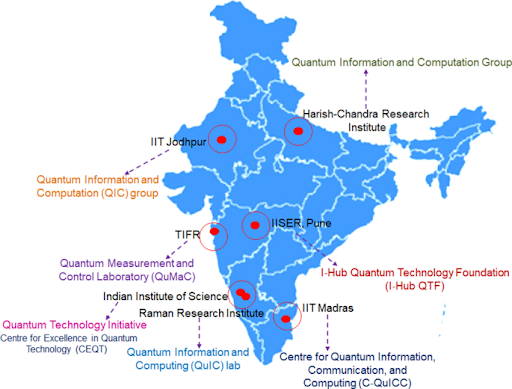
About the National Quantum Mission:
- Basics:
- Approval: Union Cabinet approved in April 2023.
- Budget: Total cost of ₹6000 crores from 2023-24 to 2030-31.
- Aim: To seed, nurture, and scale up scientific and industrial R&D in Quantum Technology (QT).
- Significance: Aims to create a vibrant, innovative ecosystem in QT, driving economic growth and positioning India as a leader in Quantum Technologies & Applications (QTA).
- Objectives:
- Quantum Computers: Develop intermediate-scale quantum computers with 50-1000 physical qubits within 8 years using platforms like superconducting and photonic technology.
- Quantum Communications: Establish satellite-based secure quantum communications between ground stations within India over 2000 km.
- International Quantum Communications: Enable long-distance secure quantum communications with other countries.
- Quantum Key Distribution: Implement inter-city quantum key distribution over 2000 km.
- Quantum Networks: Create multi-node quantum networks with quantum memories.
- Focus Areas:
- Magnetometers: Develop high-sensitivity magnetometers in atomic systems.
- Atomic Clocks: Create atomic clocks for precision timing, communications, and navigation.
- Quantum Materials: Design and synthesise quantum materials like superconductors and novel semiconductor structures for quantum device fabrication.
- Photon Sources/Detectors: Develop single photon sources/detectors and entangled photon sources for quantum communications, sensing, and metrological applications.
Implementation:
- Thematic Hubs (T-Hubs): Establish four T-Hubs in top academic and National R&D institutes, focusing on:
- Quantum Computing
- Quantum Communication
- Quantum Sensing & Metrology
- Quantum Materials & Devices
- Research & Development: These hubs will promote basic and applied research, generating new knowledge in their respective areas.
Impact & Significance:
- Global Competitiveness: Elevate India's technology development ecosystem to a globally competitive level.
- Sectoral Benefits: Benefit communication, health, financial, and energy sectors with applications in drug design, space, banking, security, etc.
- National Priorities: Boost initiatives such as Digital India, Make in India, Skill India, Stand-up India, Start-up India, Self-reliant India, and Sustainable Development Goals (SDG).
Key Findings of the Assessment report of National Quantum Mission:
- Strategic Move: Launching the ₹6,000 crore National Quantum Mission was a strategic decision to develop advanced quantum technologies.
- Global Context: India is one of 17 countries with a dedicated government program for quantum research and one of 12 nations with separate investments for this purpose.
- Investment Gap: Significant disparity in funding compared to leading countries:
- India: USD 0.75 billion
- China: USD 15 billion
- United States: USD 3.75 billion
- Technological Gap: India trails behind the US and China in patents and publications related to quantum technologies.
- Research Community:
- Principal Investigators: 110-145 Indian researchers.
- Post-Doctoral Researchers: 75-100.
- PhD Students: 300-400.
- MTech Students: 50-100.
- Educational Output: India produces the highest number of graduates in fields related to quantum technologies.
Challenges and Opportunities:
- Challenges:
- Overcome the capability gap with leading countries like the United States and China.
- Increase patent filings and publications in top journals to enhance global competitiveness.
- Opportunities:
- Leverage the large pool of researchers and students to accelerate advancements in quantum technologies.
- Utilise the National Quantum Mission to build a robust ecosystem for scientific and industrial R&D in quantum technologies, positioning India as a global leader in this domain.
Source: IE
Air pollution behind 7% of deaths in 10 cities
Why in the news ?
- A recent study in The Lancet Planetary Health journal highlighted air pollution as a significant health issue in India.
- In 10 of India's largest and most polluted cities, such as Delhi, Bengaluru, and Mumbai, 7.2% of daily deaths were attributed to PM2.5 levels exceeding safe exposure limits set by the World Health Organization (WHO).
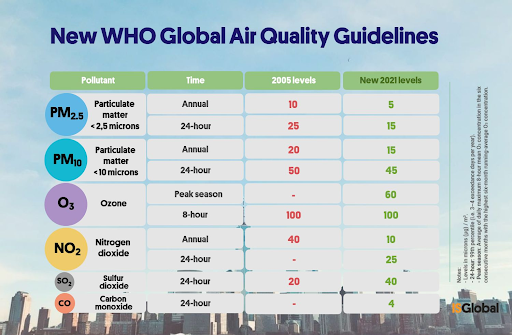
WHO’s revised air quality guidelines 2021:
- About
- In September 2021, the World Health Organization (WHO) strengthened its air quality guidelines.
- The revised norms recommend air quality levels for six pollutants:
- Ozone, nitrogen dioxide, sulphur dioxide and carbon monoxide.
- The other two are PM10 and PM2.5 -- particulate matter equal or smaller than 10 and 2.5 micrometres in diameter.
- The recommended levels for all the six pollutants have been revised downwards from the existing norms that have been in place since 2005.
- Non-binding in nature
- The WHO norms are not binding on any country.
- These are only recommended norms considered safe for human health, backed by scientific studies. However, air quality does affect the international image of a country.
Key Highlights of the Study by The Lancet Planetary Health Journal:
- Observations Regarding Delhi:
- 11.5% of annual deaths (approximately 12,000) in Delhi are attributed to air pollution, the highest among Indian cities.
- Situation Across 10 Major Cities:
- Cities studied: Ahmedabad, Bengaluru, Chennai, Delhi, Hyderabad, Kolkata, Mumbai, Pune, Shimla, and Varanasi.
- Over 33,000 deaths annually are linked to air pollution across these cities.
- Shimla has the lowest pollution-related mortality burden with 59 deaths annually (3.7% of total deaths).
- On average, 7.2% of all deaths in these cities are caused by air pollution.
- PM2.5 Exposure:
- PM2.5 levels exceed WHO's safe limit (15 micrograms per cubic metre) on 99.8% of days in these cities.
- Data collected from civil registries between 2008 and 2019, covering over 3.6 million deaths.
- Researchers utilised a machine-learning-based model for detailed PM2.5 exposure data.
- Mortality and Pollution Levels:
- Mortality increases by 1.42% for every 10 micrograms per cubic metre rise in PM2.5 levels.
- Less polluted cities, like Bengaluru and Shimla, show heightened mortality risks due to sharp increases in pollution at lower exposure levels.
- Increases in air pollution in cleaner cities can lead to higher death rates compared to cities with higher background pollution levels, such as Delhi.
- Research Insights:
- The study provides significant insights into the relationship between short-term air pollution exposure and mortality in India.
- It offers new perspectives on the health impacts of air pollution across different agro-climatological zones in India.
Steps Taken by the Indian Government:
- National Clean Air Programme (NCAP):
- Launched in January 2019 with a city-specific action plan to improve air quality.
- Targets include reducing PM2.5 and PM10 concentrations by 20-30% by 2024 from 2017 levels.
- PRANA Portal:
- Launched to monitor and facilitate the implementation of NCAP initiatives.
- National Air Quality Index (AQI):
- Introduced in October 2014 to provide easily understandable information on air quality to the public.
- Measures air quality based on eight pollutants: PM10, PM2.5, NO2, SO2, CO, O3, NH3, and Pb.
- National Ambient Air Quality Standards:
- Established under the Air (Prevention and Control of Pollution) Act, 1981.
- Set by India’s Central Pollution Control Board to regulate and maintain ambient air quality across the country.
Source: IE
UK General Election 2024
Why in the news ?
- The United Kingdom is holding a significant general election on July 4, 2024.
- Prime Minister Rishi Sunak called this snap election earlier than scheduled, potentially ending the Conservative Party's 14-year rule with the Labour Party gaining ground.

Nature of the UK Parliament:
- Bicameral Legislature:
- Consists of two houses:
- House of Commons:
- Lower house with 650 MPs elected via First-Past-The-Post (FPTP) system.
- Distribution: 533 for England; 59 for Scotland; 40 for Wales; 18 for Northern Ireland.
- Primary responsibility for law-making.
- Majority party (or coalition) forms the government; its leader becomes Prime Minister.
- Opposition comprises MPs from non-government parties.
- House of Lords:
- Upper house composed of unelected life peers, bishops, and hereditary peers.
- Reviews and proposes amendments to legislation from the Commons.
- Can delay legislation but not block bills ultimately passed by the Commons.
- House of Commons:
- Consists of two houses:
- Nature of the Governance System:
- The UK operates under a parliamentary democracy where the executive (government) derives its authority from the legislature (Parliament).
- Voting System of the United Kingdom:
- The electoral system in the UK uses First-Past-The-Post (FPTP) for electing MPs to the House of Commons.
Nature of the Governance System:
The United Kingdom operates under a constitutional monarchy and a parliamentary democracy with the following key features:
- Monarch:
- The head of state is the monarch, currently King Charles III.
- The role is primarily ceremonial, with actual political power vested in elected bodies.
- Prime Minister:
- The head of government is the Prime Minister, who leads the majority party in the House of Commons.
- Appointed by the monarch, the Prime Minister oversees government operations, makes policy decisions, and represents the UK domestically and internationally.
- Cabinet:
- The Cabinet consists of senior government ministers appointed by the Prime Minister.
- Ministers typically head government departments and are responsible for implementing government policies.
Voting System of the United Kingdom:
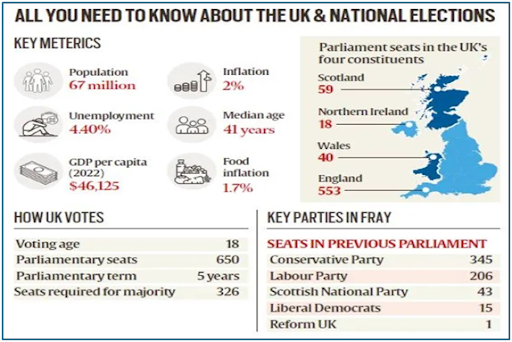
- Background
- The House of Commons, Scottish Parliament, Welsh Parliament, Northern Ireland Assembly and UK local authorities use different voting systems.
- First-Past-The-Post (FPTP):
- Used in the House of Commons, mayoral elections in England, Police and Crime Commissioner elections, and local councils in England and Wales.
- Voters choose a single candidate, and the candidate with the highest number of votes wins the seat.
- Formation of the Government:
- In the House of Commons, there are 650 seats.
- If one party secures a majority (more than 325 seats), their leader becomes the Prime Minister.
- In the event of no single party gaining a majority, a hung parliament is declared, and the largest party may seek to form a coalition government with smaller parties.
- Current Election Dynamics:
- The current election features two main contenders for Prime Minister: Rishi Sunak from the Conservative Party and Keir Starmer from the Labour Party
What does Labour's win mean for India-UK FTA?
- Background
- India and the UK have been negotiating a proposed free trade agreement (FTA) for more than two years to boost trade between the two nations.
- The agreement could result in a mutual tariff relaxation on a range of goods such as cars, clothes, alcoholic beverages, and medical instruments.
- FTA Negotiations:
- Negotiations have been ongoing for over two years with the aim to reduce tariffs on various goods like cars, clothes, alcoholic beverages, and medical instruments.
- Impact of UK Election Results:
- A landslide victory for the Labour Party in the UK elections could alter the FTA negotiation dynamics.
- Political stability following such an outcome might facilitate progress towards finalising the deal, addressing concerns of high tariffs in India's trade regime.
- Labour Party's Approach:
- Under Keir Starmer's leadership, the Labour Party has evolved, recognizing the influence of the UK's Indian-origin population, the largest immigrant group.
- Unlike his predecessor Jeremy Corbyn, Starmer's approach is expected to be more supportive of strengthening ties with India.
- Visa Issues:
- Immigration remains a contentious issue in UK politics, potentially affecting FTA negotiations.
- India seeks temporary visas for its service sector workers under the FTA, crucial for integrating with the UK's IT and financial services sectors.
- Climate Negotiations:
- A Labour government may push for stricter climate-related terms in the FTA negotiations.
- India has concerns regarding the UK's proposed carbon tax and carbon border adjustment mechanism, which could impact tariff concessions under the FTA.
Source: IE
Indian Gaur
Why in the news:
- After several decades, the locally extinct Indian gaur has been seen in the Nagarjunasagar Srisailam Tiger Reserve (NSTR) in Andhra Pradesh.

About Indian Gaur:
- Common Name: Indian Bison or Gaur
- Scientific Name: Bos gaurus
- Distribution: Indigenous to South and Southeast Asia
- Habitat: Primarily found in evergreen, semi-evergreen, and moist deciduous forests with open grasslands. They prefer hilly terrains below an altitude of 1,500-1,800 metres with large, undisturbed forest tracts and abundant water.
- Physical Features:
- Length: 240 cm to 340 cm
- Tail Length: 70 cm to 105 cm
- Height: 170 cm to 230 cm
- Weight: Adult males weigh 600 kg to 1500 kg; adult females weigh 400 kg to 1000 kg
- Forehead: Convex shape
- Limbs: Strong and sturdy
- Horns: Both males and females have horns that are pale green or yellowish-brown with a slightly inward curvature.
- Tail: Typically short
- Social Behavior: Gaurs are social animals living in groups of about 30 to 40.
- Conservation Status:
- IUCN Red List: Vulnerable
- Wildlife Protection Act, 1972: Schedule I
- CITES: Appendix I
Key Facts about Nagarjunasagar Srisailam Tiger Reserve (NSTR):
- Location: Situated in the Nallamala hill ranges (an offshoot of the Eastern Ghats) of Andhra Pradesh, spanning the undivided districts of Guntur, Prakasam, and Kurnool.
- Status: Attained Tiger Reserve status in 1983.
- Area: The largest tiger reserve in India, covering 5,937 sq km.
- Naming: Named after two major dams in the area, Nagarjuna Sagar Dam and Srisailam Dam.
- Wildlife Sanctuaries: Includes Rajiv Gandhi Wildlife Sanctuary and Gundla Brahmeswaram Wildlife Sanctuary (GBM).
- River Krishna: Traverses through the reserve for about 270 kilometres.
- Topography: Features plateau, ridges, gorges, and deep valleys.
- Vegetation: Tropical dry deciduous forests with undergrowth of bamboo and grass.
- Flora: Several endemic species including Andrographis nallamalayana, Eriolaena lushingtonii, Crotalaria madurensis Var, Dicliptera beddomei, and Premna hamiltonii.
- Fauna:
- Top Predators: Tiger, Leopard, Wolf, Wild Dog, and Jackal.
- Prey Species: Sambar, Chital, Chowsingha, Chinkara, Mouse Deer, Wild boar, and Porcupine.
- River Species: Muggers, Otters, and Turtles in the river Krishna.
Source: TOI
Nightjars
Why in the news ?
- A team of scientists recently described a new species of nightjar, named Caprimulgus ritae, found in the tropical forests of Timor and Wetar, Lesser Sunda Islands.

About Nightjars:
- Family: Caprimulgidae
- Order: Caprimulgiformes
- Distribution: Found worldwide except in Antarctica and certain island groups, such as the Seychelles.
- Features:
- Medium-sized nocturnal insectivorous birds.
- Long wings, short legs, and very short bills.
- Feed on flying insects caught on the wing at night.
- Grey-brown, mottled, streaked, and stripey plumage providing ideal camouflage during the day.
- Sleep on the ground or perched lengthwise on a branch during the day.
- Notoriously difficult to study due to their nocturnal behaviour and cryptic plumage.
Key Facts about Lesser Sunda Islands:
- Location: An archipelago in maritime Southeast Asia, immediately east of Java and north of Western Australia.
- Major Islands: Includes Bali, Lombok, Sumbawa, Flores, Sumba, and Timor.
- Geography: Part of a volcanic arc, the Sunda Arc, formed by subduction along the Sunda Trench in the Java Sea.
- Sunda Islands: Together with the Greater Sunda Islands to the west, they constitute the Sunda Islands.
Source: SN
Megafauna
Why in the news ?
- Recently, A team of archaeologists has discovered a 41,000-year-old ostrich nest in Prakasam, Andhra Pradesh.
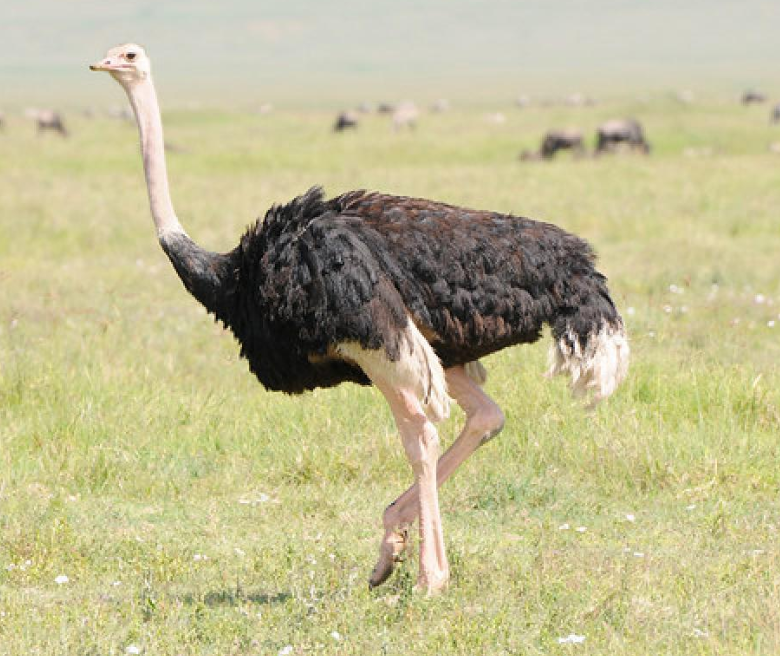

About Megafauna:
- Definition: Generally used to describe animals weighing more than 50 kg.
- Origin of the Term: Coined by the English naturalist and explorer Alfred Russel Wallace in his 1876 book, The Geographical Distribution of Animals.
- Classification:
- Megaherbivores: Plant-eaters
- Mega Carnivores: Meat-eaters
- Mega Omnivores: Eat both plants and meat
- Ostriches: Classified as mega omnivores
- Weight: Between 90 and 140 kg
- Height: Between seven and nine feet
Historical Evidence of Megafauna:
- Early Documentation:
- Richard Lydekker presented the earliest documented evidence of megafauna in the subcontinent in 1884, found in the Dhok Pathan deposits in the Upper Siwalik (Shivalik) Hills, present-day Pakistan.
- Patne, Maharashtra:
- In 1989, archaeologist S A Sali discovered ostrich eggshell beads and engraved pieces dating back to approximately 50,000–40,000 years ago at an Upper Palaeolithic open-air camping site.
- CCMB Research (2017):
- Researchers at the Centre for Cellular and Molecular Biology (CCMB) in Hyderabad assessed fossilised eggshells from Rajasthan, Madhya Pradesh, and Gujarat, establishing the presence of ostriches 25,000 years ago.
Source: IE
Meta 3D Gen AI System
Why in the news ?
- Meta has recently introduced an advanced AI tool capable of generating or retexturing 3D objects in under a minute.

About Meta 3D Gen AI System:
- Functionality: Generates high-quality 3D assets with high-resolution textures and material maps in under a minute.
- Components: Utilises two AI-powered sub-systems: Meta 3D AssetGen and Meta 3D TextureGen.
- Capabilities:
- Generates 3D content such as characters, props, or scenes from text prompts.
- Adds texture to already created 3D meshes (structures of 3D models).
How It Works:
- Technique: Uses Physically-Based Rendering (PBR) to build 3D content.
- Process:
- User Input: The system receives instructions for creating a 3D structure and its design elements, including texture.
- Stage One: Meta 3D AssetGen creates an initial 3D asset based on the user prompt. This involves generating a 3D mesh with texture and PBR material maps, taking approximately 30 seconds.
- Stage Two: Meta 3D TextureGen enhances the quality of the texture and PBR maps for the 3D asset generated in stage one. This step takes about 20 seconds.
- Standalone Use:
- Meta 3D TextureGen can function independently as a text-to-texture generator.
- If provided with a pre-generated 3D mesh and a text prompt detailing the desired texture, the system automatically performs step two.
Source: TH
UNESCO warns 90% of Earth’s land could be degraded by 2050
Why in the news ?
- Recently, UNESCO issued a stark warning, projecting that 90% of the planet's land surface could be degraded by 2050.
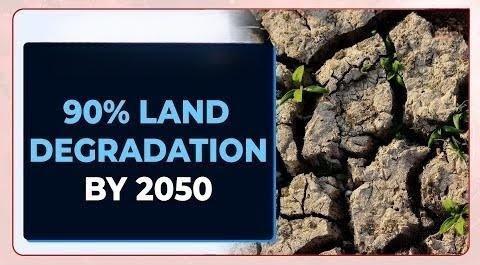
Status of land degradation:
- Current Degradation: According to the World Atlas of Desertification, 75% of soils are presently degraded, directly impacting 3.2 billion people worldwide.
- Further Degradation: If current practices continue unchecked, the degradation rate could escalate, potentially affecting 90% of soils by 2050.
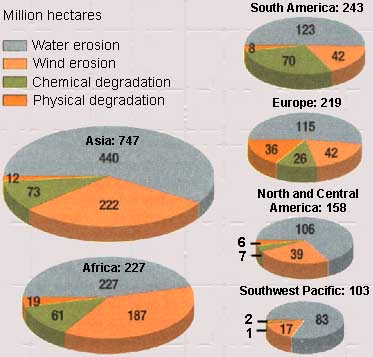
What are the causes of land degradation and desertification?
- Deforestation: Removal of vegetation cover leads to soil erosion and loss of biodiversity. Globally, deforestation affects around 13 million hectares annually.
- Overgrazing: Intensive grazing by livestock reduces vegetation cover, leading to soil compaction and erosion. Over 70% of global drylands are affected by overgrazing.
- Agricultural Practices: Unsustainable farming methods such as monoculture, excessive tillage, and improper irrigation contribute to soil erosion and nutrient depletion. About 1/3 of the world's land is degraded due to agriculture.
- Climate Change: Increasing temperatures and changing rainfall patterns exacerbate soil degradation and desertification. Over 25% of the Earth's land is experiencing desertification due to climate change.
- Urbanisation: Expansion of cities and infrastructure leads to land cover change, soil sealing, and reduced infiltration capacity, impacting about 1.5 million square kilometres of land annually.
|
India lost over 30 million hectares of healthy land to degradation:
|
What are the Impacts of Land Degradation and Desertification ?
- Loss of Agricultural Productivity:
- Soil degradation reduces global crop yields by about 33%, contributing to food shortages and poverty (FAO).
- Example: In sub-Saharan Africa, soil degradation reduces maize yields by up to 50%, affecting food security and livelihoods.
- Global Food Security:
- Land degradation threatens global food security, compromising the well-being of at least 3.2 billion people worldwide (UNCCD).
- Example: In parts of Asia, such as India and China, degradation reduces rice yields, impacting food availability for millions.
- Environmental Degradation:
- Impacts water quality, biodiversity, and ecosystem services.
- Example: Soil erosion leads to sedimentation in rivers, affecting aquatic habitats and reducing water quality for communities downstream.
- Water Management Issues:
- Disrupts water infiltration, storage, and drainage in soils, leading to waterlogging and water scarcity.
- Example: In arid regions like the Sahel in Africa, overgrazing and deforestation reduce vegetation cover, exacerbating soil erosion and water scarcity.
- Economic Impact:
- Reduces land productivity, impacting livelihoods dependent on agriculture and natural resources.
- Example: In Central America, soil erosion and degradation threaten coffee plantations, a critical economic sector, affecting incomes and rural communities.
- Social and Cultural Impacts:
- Erodes cultural identities and traditional knowledge of Indigenous Peoples and local communities.
- Example: In Australia, degradation affects Aboriginal communities' connection to ancestral lands and traditional practices.
- Migration and Conflict:
- Contributes to migration as people seek alternative livelihoods, exacerbating social tensions and conflicts over dwindling resources.
- Example: In parts of Africa, land degradation and desertification contribute to migration, leading to resource-based conflicts and displacement.
- Climate Change Feedbacks:
- Degraded lands emit greenhouse gases and reduce carbon sequestration capacity, contributing to climate change.
- Example: Deforestation in the Amazon rainforest accelerates climate change through reduced carbon storage and altered regional climate patterns
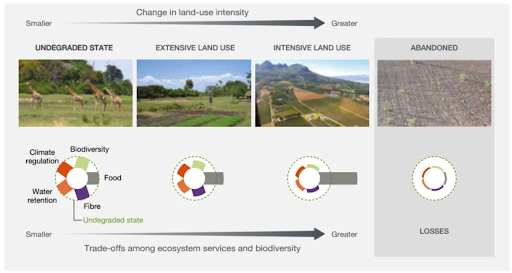
Government measures to combat land degradation and desertification in India:
- Watershed Development Component (WDC) of Pradhan Mantri Krishi Sinchayee Yojana:
- Implements interventions like building water harvesting structures, expanding protected irrigation, and promoting afforestation and horticulture.
- Aims to restore degraded land and improve water management.
- Land Degradation Neutrality (LDN) Status by 2030:
- India has committed to achieving LDN status by 2030, aiming to maintain or improve the health of its land resources.
- National Afforestation Programme (NAP):
- Implemented by the National Afforestation & Eco Development Board (NAEB), Ministry of Environment, Forests and Climate Change.
- Focuses on regenerating degraded forests and adjoining areas with community participation.
- Desertification and Land Degradation Atlas:
- Published by the Space Applications Centre (SAC) of the Indian Space Research Organisation (ISRO).
- Provides state-wise information on degraded land areas to aid in planning restoration efforts.
- Online Portal for Visualization:
- Developed in collaboration with SAC, Ahmedabad.
- Allows visualisation of degraded land areas and the processes causing degradation, aiding in monitoring and management.
- Centre of Excellence at ICFRE Dehradun:
- Established at the Indian Council for Forestry Research and Education (ICFRE), Dehradun.
- Focuses on South-South Cooperation for sharing knowledge and best practices in combating land degradation
Global initiatives by UNESCO on land degradation:
- World Soil Health Index:
- A standardised measure to assess and compare soil quality across different regions and ecosystems worldwide.
- Aims to provide a unified approach for monitoring and improving soil health globally.
- Pilot Initiative under Biosphere Reserves Programme:
- UNESCO will launch a pilot initiative for sustainable management of soils and landscapes in approximately ten natural sites protected under its Biosphere Reserves programme.
- Objectives include:
- Assessing the effectiveness of management methods implemented in these sites.
- Facilitating the adoption of successful methods in other regions to promote sustainable land management practices globally
|
UPSC Civil Services Examination, Previous Year Questions Prelims: Q:1 What is/are the importance/importances of the ‘United Nations Convention to Combat Desertification'? (2016)
Select the correct answer using the code given below:
Ans: (c) Mains: Q:1 The process of desertification does not have climate boundaries. Justify with examples. (2020) Q:2 In what way micro-watershed development projects help in water conservation in drought-prone and semi-arid regions of India? (2016) |
Source: DTE
Share the article
Get Latest Updates on Offers, Event dates, and free Mentorship sessions.

Get in touch with our Expert Academic Counsellors 👋
FAQs
UPSC Daily Current Affairs focuses on learning current events on a daily basis. An aspirant needs to study regular and updated information about current events, news, and relevant topics that are important for UPSC aspirants. It covers national and international affairs, government policies, socio-economic issues, science and technology advancements, and more.
UPSC Daily Current Affairs provides aspirants with a concise and comprehensive overview of the latest happenings and developments across various fields. It helps aspirants stay updated with current affairs and provides them with valuable insights and analysis, which are essential for answering questions in the UPSC examinations. It enhances their knowledge, analytical skills, and ability to connect current affairs with the UPSC syllabus.
UPSC Daily Current Affairs covers a wide range of topics, including politics, economics, science and technology, environment, social issues, governance, international relations, and more. It offers news summaries, in-depth analyses, editorials, opinion pieces, and relevant study materials. It also provides practice questions and quizzes to help aspirants test their understanding of current affairs.
Edukemy's UPSC Daily Current Affairs can be accessed through:
- UPSC Daily Current Affairs can be accessed through Current Affairs tab at the top of the Main Page of Edukemy.
- Edukemy Mobile app: The Daily Current Affairs can also be access through Edukemy Mobile App.
- Social media: Follow Edukemy’s official social media accounts or pages that provide UPSC Daily Current Affairs updates, including Facebook, Twitter, or Telegram channels.



